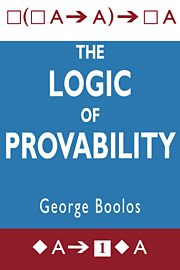Book contents
- Frontmatter
- Contents
- Preface
- Introduction
- 1 GL and other systems of propositional modal logic
- 2 Peano arithmetic
- 3 The box as Bew(x)
- 4 Semantics for GL and other modal logics
- 5 Completeness and decidability of GL and K, K4, T, B, S4, and S5
- 6 Canonical models
- 7 On GL
- 8 The fixed point theorem
- 9 The arithmetical completeness theorems for GL and GLS
- 10 Trees for GL
- 11 An incomplete system of modal logic
- 12 An S4-preserving proof-theoretical treatment of modality
- 13 Modal logic within set theory
- 14 Modal logic within analysis
- 15 The joint provability logic of consistency and ω-consistency
- 16 On GLB: The fixed point theorem, letterless sentences, and analysis
- 17 Quantified provability logic
- 18 Quantified provability logic with one one-place predicate letter
- Notes
- Bibliography
- Index
- Notation and symbols
Introduction
Published online by Cambridge University Press: 08 January 2010
- Frontmatter
- Contents
- Preface
- Introduction
- 1 GL and other systems of propositional modal logic
- 2 Peano arithmetic
- 3 The box as Bew(x)
- 4 Semantics for GL and other modal logics
- 5 Completeness and decidability of GL and K, K4, T, B, S4, and S5
- 6 Canonical models
- 7 On GL
- 8 The fixed point theorem
- 9 The arithmetical completeness theorems for GL and GLS
- 10 Trees for GL
- 11 An incomplete system of modal logic
- 12 An S4-preserving proof-theoretical treatment of modality
- 13 Modal logic within set theory
- 14 Modal logic within analysis
- 15 The joint provability logic of consistency and ω-consistency
- 16 On GLB: The fixed point theorem, letterless sentences, and analysis
- 17 Quantified provability logic
- 18 Quantified provability logic with one one-place predicate letter
- Notes
- Bibliography
- Index
- Notation and symbols
Summary
The theme of the present work is the way in which modal logic, a branch of logic first studied by Aristotle, has been found to shed light on the mathematical study of mathematical reasoning, a study begun by David Hilbert and brought to fruition by Kurt Gödel.
Modal logic
The basic concepts of modal logic are those of necessity and possibility: A statement is called “possible” if it might be true (or might have been true) and “necessary” if it must be true (or could not have been untrue). E.g., since there might be a war in the year 2000, the statement that there will be a war then is possible; but the statement is not necessary, for there might not be one. On the other hand, the statement that there will or won't be a war in 2000 is necessary.
Necessity and possibility are interdefinable: a statement is necessary iff (if and only if) its negation is not possible, and, therefore, a statement is possible iff its negation is not necessary.
The customary sign for necessity in modal logic is the box, ‘□’, read ‘necessarily’, or ‘it is necessary that…’; the sign for possibility is the diamond ‘◊’, read ‘possibly,’ or ‘it is possible that…’. Thus like ∧ and ∨ and ∀ and ∃, either one of □ and ◊ can be regarded as defined from the other, □ as ¬◊¬ and ◊ as ¬□¬. We shall usually take □ as primitive and ◊ as defined: ‘◊A’ will abbreviate: ‘¬□¬A’.
- Type
- Chapter
- Information
- The Logic of Provability , pp. xv - xxxviPublisher: Cambridge University PressPrint publication year: 1994



